
The Armed Forces of Gabon, officially the Gabonese Defense and Security Forces, is the national professional military of Gabon, divided into the Army, Air Force, Navy, and a National Gendarmerie, consisting of about 5,000 personnel. The armed forces includes a well-trained, well-equipped 1,800-member guard that provides security for the President of Gabon.
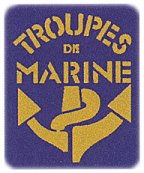
The Troupes de Marine or TDM, sometimes simply referred to as "French Marines" in English, are one of the major components of the French Army and comprise several specialties: infantry, airborne, armoured cavalry, artillery, engineering, and transmissions (signals). Characterized by their fundamental vocation for service beyond the seas, including in French overseas territories and, formerly, in French colonies, the Marines have taken part in all French military campaigns since the corps' foundation, both on home soil and in theaters of operations around the world. They are stationed in Metropolitan France, in many French overseas departments and territories, as well as in Africa.

The 1st Foreign Engineer Regiment is one of two combat engineer regiments of the Foreign Legion in the French Army. The regiment provides the combat engineering component of the 6th Light Armoured Brigade.

The 1st Marine Infantry Parachute Regiment or 1er RPIMa is a unit of the French Army Special Forces Command, therefore part of the Special Operations Command.
The structure of the French Army is fixed by Chapter 2 of Title II of Book II of the Third Part of the Code of Defense, notably resulting in the codification of Decree 2000-559 of 21 June 2000.

The 6th Marine Infantry Parachute Regiment is an airborne infantry unit of the French Army.

The 1st Free French Division was one of the principal units of the Free French Forces (FFL) during World War II, renowned for having fought the Battle of Bir Hakeim.

The 9th Marine Infantry Brigade is a light armoured, amphibious unit of the Troupes de marine of the French Army.
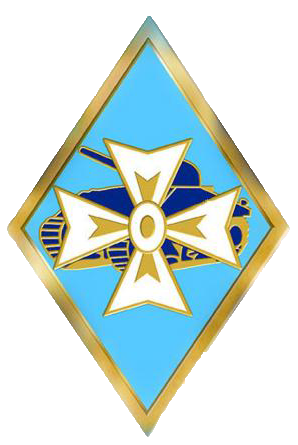
The 1st Armored Division is a unit of the French Army formed during World War II that took part in the Liberation of France.

The 2nd Marine Infantry Regiment is an infantry regiment of the Troupes de marine in the French Army, the only regiment to bear 16 battle honours inscriptions of the regimental colors. The regiment is one of the "quatre vieux" regiments of the Troupes de marine, with the 1st Marine Infantry Regiment 1er RIMa, the 3rd Marine Infantry Regiment 3e RIMa and the 4th Marine Infantry Regiment 4e RIMa ; also, alongside the 1st Marine Artillery Regiment 1er RAMa as well as the 2nd Marine Artillery Regiment 2e RAMa which formed the Blue Division.
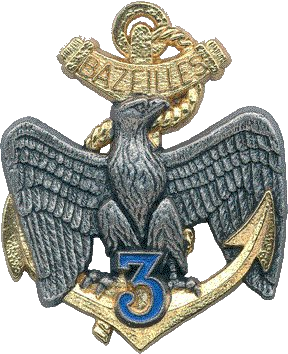
The 3rd Marine Infantry Regiment is a unit of the French Army. The 3e RIMa is one of the oldest of the troupes de marine. This regiment is one of the "Quatre Grands" of marine infantry once garrisoned within the four military ports, ready to embark : the « Grand Un », the « Grand Deux », the « Grand Trois » and the « Grand Quatre ». The regiment fought in the expeditions of the 19th century in Africa, the Americas, Oceania and the Orient. Surnamed also the "3rd Marine", the unit was part of the « Blue Division » which fought at the Battle of Bazeilles on August 31 and September 1, 1870. The regiment is part of the 9th Light Armoured Marine Brigade.

The 6th Foreign Infantry Regiment was an infantry regiment of the Foreign Legion in the French Army from 1939 to 1941 and again from 1949 to 1955.
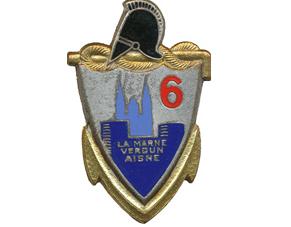
The 6th Engineers Regiment is a regiment of the génie militaire of the French Military constituted under the IIIrd Republic. It is the only Engineers Regiment among the Troupes de Marine.
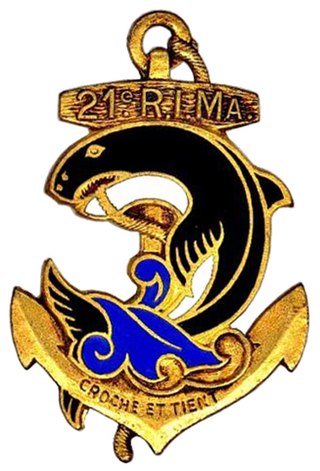
The 21st Marine Infantry Regiment is an infantry regiment of the Troupes de Marine issued by filiation from the 2e RIC.

Captain in the U.S. Army (USA), U.S. Marine Corps (USMC), U.S. Air Force (USAF), and U.S. Space Force (USSF) is a company-grade officer rank, with the pay grade of O-3. It ranks above first lieutenant and below major. It is equivalent to the rank of lieutenant in the Navy/Coast Guard officer rank system and is different from the higher Navy/Coast Guard rank of captain. The insignia for the rank consists of two silver bars, with slight stylized differences between the Army/Air Force version and the Marine Corps version.
The Division Daguet was a French Army division formed in September 1990 in Saudi Arabia as part of France's contribution to Operation Desert Shield. The French military contribution to the allied cause to liberate Kuwait from Iraqi occupation was named Opération Daguet and its ground part was subsequently named Division Daguet. In French "Daguet" is a young brocket deer.

The Specialized Staff for Overseas and Foreign Affairs was historically dedicated to training the French Army in interculturality and was the maison mere (mother-parent) of the Troupes de marine. It is located at the Ecole militaire in Paris and at Fréjus.













